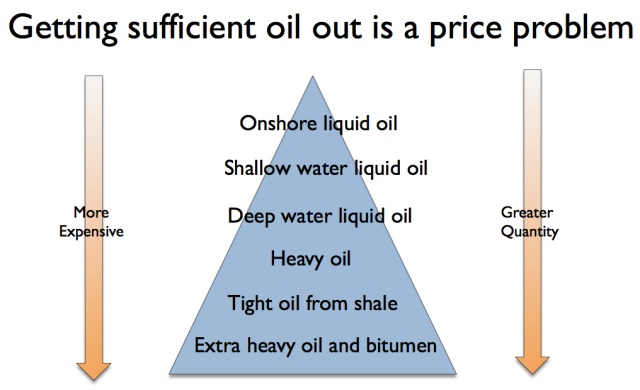A fairly insightful piece on the how oil price rises drive more fossil fuel production,
 currently fueled by debt because wages of most workers have been falling, still misses two big points: solar prices continually plumetting now undercut all fossil fuel prices, and dirtier fossil fuel extraction and its massive colonial invasion of pipelines are meeting resistance everywhere, including at the regulatory-captured puppet agencies like FERC.
currently fueled by debt because wages of most workers have been falling, still misses two big points: solar prices continually plumetting now undercut all fossil fuel prices, and dirtier fossil fuel extraction and its massive colonial invasion of pipelines are meeting resistance everywhere, including at the regulatory-captured puppet agencies like FERC.
“Tyler Durden”, ZeroHedge, 13 May 2016, Submitted by Gail Tverberg via Our Finite World blog, The Real Oil Limits Story – What Other Researchers Missed,
Because of the availability of an increasing amount of resources, we are likely to get more oil, natural gas, and coal, if prices rise. We associate high prices with scarcity; instead, high prices tend to make a larger quantity of energy product available.
The International Energy Agency (IEA) has a different way of illustrating the likelihood of huge future oil supply, if prices can only rise high enough.
And there’s another rub in her thinking: oil and gas prices have fallen, not risen, due to Saudi Arabia flooding the market to damage Russia, Iran, and U.S. frackers. Which has forced the “shale gas revolution” to run even more on debt fumes. Which means its house of cards will come crashing down soon, as the carbon bubble pops.
Here is the handwriting on the solar panel, by none other than Eric Silagy, FPL president and CEO.
Bruce Ritchie, PoliticoFloridabeta, Florida utilities move toward solar energy as price drops,
TALLAHASSEE — The biggest barrier for solar energy in Florida had always been the cost.
But that’s changing as the price of solar continues to drop, making it as cheap — or cheaper — as traditional sources of electricity generation.
Florida utilities are taking advantage of the lower costs.
Florida Power & Light Co. is building a 74.5-megawatt solar facility at the Babcock Ranch housing development in Lee County, one of three solar projects FPL announced in February. Together, the projects will generate 225 megawatts, which is enough energy to power 45,000 homes.
“This is the first time we have been able to build cost-effective (solar) in Florida,” said Alys Daly, FPL’s manager of public affairs.
In December, Gulf Power signed a contract with Coronal Development Services to build solar power stations at three military bases in the Florida Panhandle. The nearly 1.5 million solar panels will generate up to 120 megawatts of electricity that can power 18,000 homes on a sunny day.
FPL acts like it didn’t know that way back in 2013 the electric utility industry’s own think tank, Edison Electric Institute, told them all that solar was going to eat their lunch unless they got out in front.
FPL acts like it didn’t know that a year ago Southern Company pivoted from solar maybe by the end of the decade to there’s a market for it and we’re going to sell it and if it threatens our utility we’re going to own it. That’s why SO subsidiary Gulf Power is building those military-base solar plants in Florida, after SO subsidiary Georgia Power already built a bunch in Georgia. Like FPL didn’t know Southern Company’s 2016 Annual Meeting Notice touts: “Growth in Renewables Approximately 3,800 megawatts of announced or added renewable capacity since 2012. This includes the development of what is expected to be the largest voluntary solar portfolio in the U.S. (at Georgia Power Company).” Southern Company has even bought a smart grid company to help integrate solar and wind power.
FPL acts like it didn’t know that bank researchers from Citi GPS to UBS Warburg to Goldman Sachs for years have been saying get on board with the solar revolution or get left behind.
That’s the same FPL that’s wasting $3 billion of its ratepayers dollars on the Sabal Trail fracked methane pipeline boondoggle. Except, wait! FPL can’t possibly have collected all those funds from its ratepayers yet, which means it’s almost certainly leveraging it through debt. Which means as FPL shifts to solar power, as even FPL will, like Southern Company is already doing, that 500-mile pipeline IED will also be a stranded asset. Along with all its ugly stepsister power plants, LNG exports, and bomb trains.
And Duke Energy, also owner of part of Sabal Trail:
Duke Energy, Florida’s second largest utility behind FPL, says it has a long-range plan to install 35 megawatts of solar by 2018 and up to 500 megawatts by 2024.
“As the cost of solar energy continues to decrease, we’re increasing our investments in this resource,” Duke Energy Florida president Alex Glenn said in an announcement last September.
So why are you still building a fracked methane power plant to use Sabal Trail gas next to your failed Crystal River nuke, Duke?
Despite the lower costs, solar may not always be cheaper than natural gas, FP&L officials say.
Uhuh. And the Internet will never replace CompuServ. Meanwhile wind and solar power are getting twice the investment of gas and coal. Which means that the 6% of world GDP that currently subsidizes fossil fuels, more than all the world’s government health care spending, is going to come crashing down before long.
 You’re betting on the wrong pipeline horse, FPL (and your little Turkey Point nukes, too).
Solar power will win like the Internet did.
You’re betting on the wrong pipeline horse, FPL (and your little Turkey Point nukes, too).
Solar power will win like the Internet did.
I’ve got an idea: let’s not waste money and the countryside and our waters! Let’s just not build that boondoggle. Let the sun rise on Florida, Georgia, Alabama, and the world!
-jsq
Short Link:
